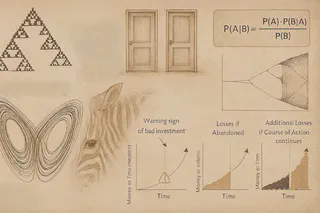The Monty Hall Problem in Digital Transformation: Overcoming Cognitive Biases

We like to believe we’re rational decision-makers, especially when leading digital initiatives. This has been my consistent observation. Yet two subtle cognitive habits often shape our choices more than data ever could. (Of course, real-world decision-making is far more complex than any framework can fully capture, but these patterns are still worth exmining.)
Take the Monty Hall problem. Three doors. Behind one is a prize. You pick one. The host opens another and shows it’s empty. You’re asked: stick or switch?
Most people stick. But Bayesian reasoning tells us to switch.
Why don’t we?
Now think of the sunk cost fallacy. You’ve spent a year on a project. Time, money, energy. It’s not working. But instead of letting go, you keep going. Because of everything you’ve already invested.
Why?
While these examples simplify complex decision processes, they highlight patterns that emerge even in sophisticated business contexts. Both situations feel different, but the thinking is the same. We commit early. We ignore new information. We assume our first decision is better than it is.
I’ve been working with a PhD in DS student on nonlinear dynamics. We are exploring how simple rules give rise to complex behaviors. We’re combining DL techniques and the classic cellular automata to build something more meta: a model that predicts which kinds of frameworks are likely to produce the patterns we see. In a sense, we’re modeling the model. This project has become a perfect laboratory for observing our own cognitive biases in action.
The academic project seems ambitious. And after a year, we’re still stuck. 😅 The sub-models work. But the overall picture is still fuzzy. Still, it’s tempting to keep pushing forward… to avoid stepping back, questioning our assumptions, or shifting our frame.
But building models is only part of the work. The harder part is recognizing when the model no longer fits. When the structure we started with isn’t capturing what matters. When it’s time to ask: should we shift? Should we reframe?
Now back to digital transformation, sunk costs show up as legacy systems, outdated processes, or half-built models we’re afraid to stop using. Can we switch doors when the data tells us to?
Sure, the original idea may have opened the door. But progress sometimes comes from walking away and trying another. That said, there are certainly cases where persistence through difficulties leads to breakthrough. And distinguishing between productive perseverance and the sunk cost fallacy is the real art! Just like tuning the hyper-parameters of our deep learning models 😉